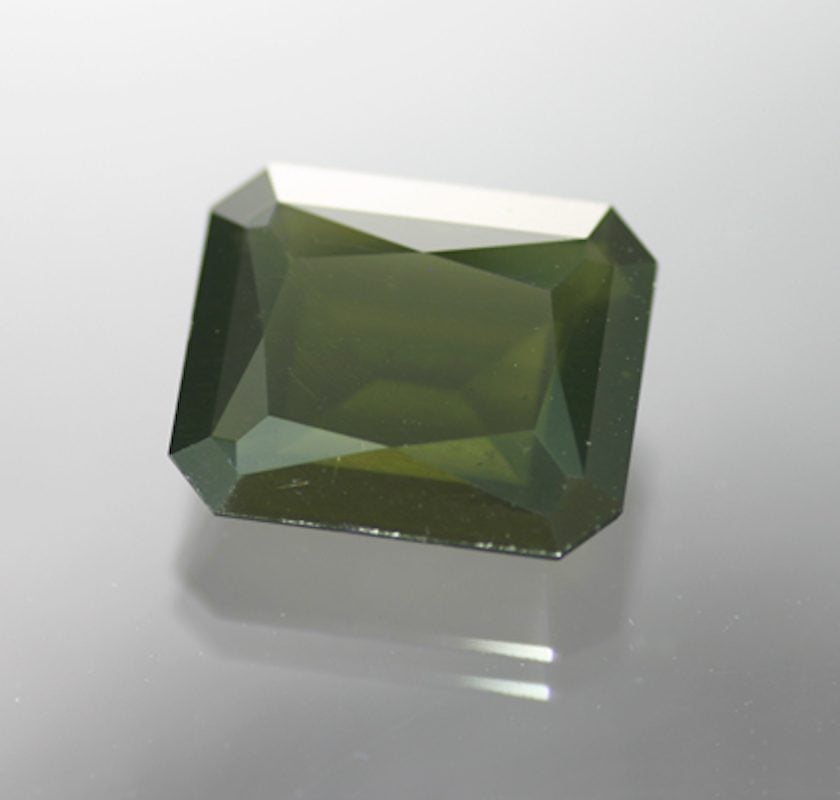Ekanite Value, Price, and Jewelry Information
A relative newcomer to the world of gemstones, ekanite is rare and usually quite radioactive. When cabbed, some ekanites can display a star stone effect.
2 Minute Read
A relative newcomer to the world of gemstones, ekanite is rare and usually quite radioactive.
Start an IGS Membership today
for full access to our price guide (updated monthly).Ekanite Value
What is Ekanite?
The gemologist F. L. D. Ekanayake discovered ekanite as two cabochon-cut gemstones in a market in Colombo, Sri Lanka in 1953. When he examined these unknown stones, he found they had unusual optical and physical properties. He later discovered the source of these and other similar stones in gravel beds in Eheliyagoda, near Ratnapura, Sri Lanka. In 1961, scientists confirmed the mineral as a new species and named it ekanite after its discoverer.
Other sources of ekanite have emerged, but it remains a rare gemstone. More stones undoubtedly exist, perhaps misidentified and sold as other Sri Lankan gems. However, the total number of gems is still a mere handful.
Although ekanite has a tetragonal crystal system, it's usually metamict as a result of its uranium (U) and thorium (Th) content. This means it loses its crystalline structure due to radioactivity, becoming amorphous, like glass. Other gemstone properties may also vary depending on the degree of radiation damage.
Is Ekanite Safe for Jewelry Use?
Metamict ekanite may be strongly radioactive, so jewelry use isn't recommended.
Test any ekanite you're going to handle or store with a Geiger counter. You can also use the radioactivity chart on the webmineral ekanite listing to estimate how much exposure in mRem per hour ekanites of different sizes may cause if held in hand.
Please note: the average annual estimated exposure in the U.S. from background radiation, medical sources, and consumer products is 360 mRem. To put this in perspective, at almost 500 cts (about 100 g), a little over 20 hours of holding the world's largest ekanite would alone match the average annual estimated exposure. A 5-ct ekanite (1 gram) would take a little over 83 days of close contact to match the annual average estimate.
Are There Star Stone Ekanites?
The first ekanite gems discovered displayed asterism in the form of a 4-ray star effect. This phenomenal effect is rare, but in addition, 6-ray and 8-ray stars have since been discovered. Ekanites may also display chatoyancy (cat's eyes) as well as Tyndall scattering.
Where is Ekanite Found?
Sri Lanka has produced most known ekanites, as translucent green pebbles from gem gravels in Eheliyagoda and in placer deposits from Okkampitiya.
Small, crystalline (non-metamict) ekanites have been found in Yukon,Canada.
Other notable sources include the following locations:
- Quebec (metamict); Tombstone Mountains, Yukon (crystalline), Canada.
- Monte Somma, Vesuvius, Italy; Kyrgyzstan; Myanmar; Tulare County, California, United States.
Stone Sizes
London Gem Labs tested a 43.8-ct stone in 1975. A 351-ct rough has also been reported.
In 1999, a 161-ct star stone cabochon was examined by the GIA. It may have held the record for the largest finished ekanite gem. However, a report emerged in 2016 of a 498-ct gem from Welimada, Sri Lanka.
Storing Ekanites
For storage and display, keep any samples enclosed and separated from other gems (radiation may affect their color) and use radon detectors to monitor the buildup of radon gases in the storage container as well as the room.
For more information on how to safely handle, store, and cut ekanites, follow the recommendations for radioactive materials in our safety guide. You can find additional safety information on webmineral.com.
Joel E. Arem, Ph.D., FGA
Dr. Joel E. Arem has more than 60 years of experience in the world of gems and minerals. After obtaining his Ph.D. in Mineralogy from Harvard University, he has published numerous books that are still among the most widely used references and guidebooks on crystals, gems and minerals in the world.
Co-founder and President of numerous organizations, Dr. Arem has enjoyed a lifelong career in mineralogy and gemology. He has been a Smithsonian scientist and Curator, a consultant to many well-known companies and institutions, and a prolific author and speaker. Although his main activities have been as a gem cutter and dealer, his focus has always been education. joelarem.com
International Gem Society
Related Articles
Black Diamond Value, Price, and Jewelry Information
Chameleon Diamond Value, Price, and Jewelry Information
Gray Diamond Value, Price, and Jewelry Information
Green Diamond Value, Price, and Jewelry Information
Latest Articles
Quartz Toxicity: Understanding the Risks for Jewelers and Wearers
Synthetic Amethyst: What is it and How is it Made?
Hambergite Value, Price, and Jewelry Information
Pearl Simulants: How to Spot Faux Pearls
Never Stop Learning
When you join the IGS community, you get trusted diamond & gemstone information when you need it.
Get Gemology Insights
Get started with the International Gem Society’s free guide to gemstone identification. Join our weekly newsletter & get a free copy of the Gem ID Checklist!
